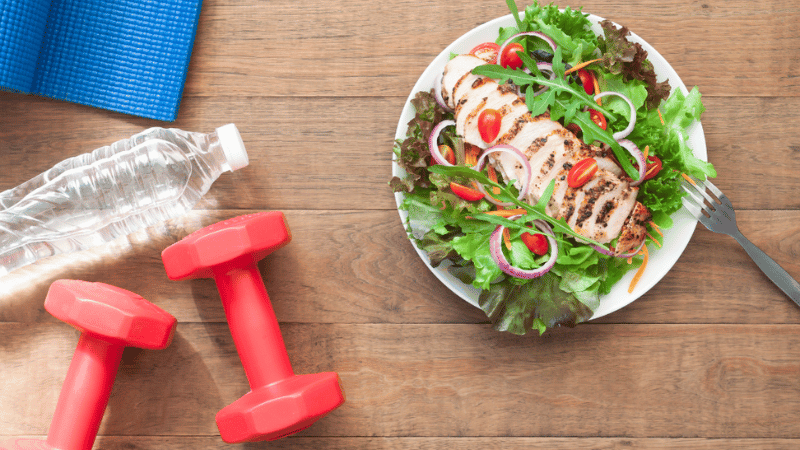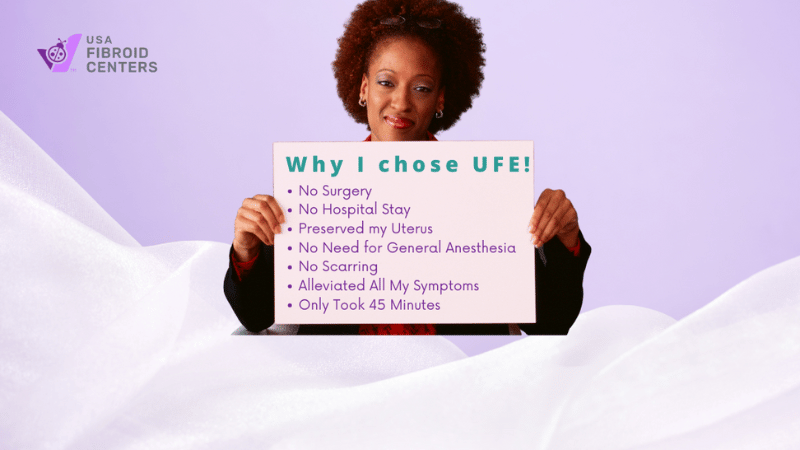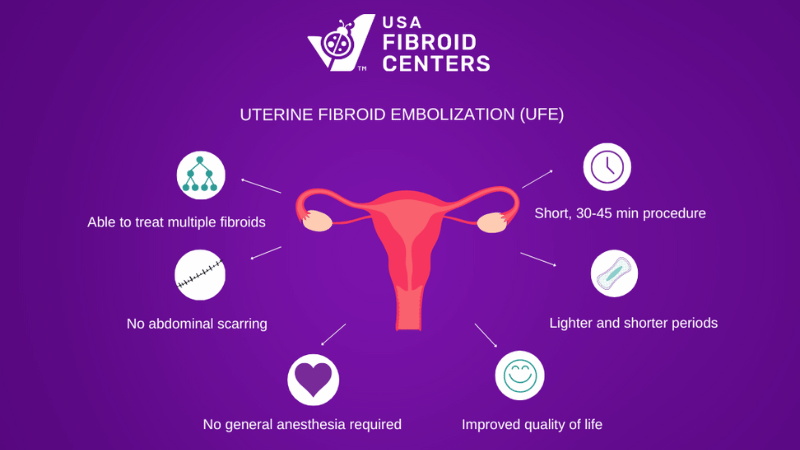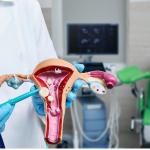
Undergoing Uterine Fibroid Embolization (UFE) can help eliminate fibroids and is becoming a more popular option due to being a less invasive alternative to getting a hysterectomy. UFE is a specialized, minimally invasive procedure aimed at treating fibroids effectively, focusing on reducing the fibroids’ size and alleviating associated symptoms.
The UFE procedure involves the precise delivery of embolic agents to the arteries supplying the fibroids, effectively cutting off their blood supply and causing them to shrink and eventually die. This process is performed under imaging guidance, ensuring accuracy and minimizing impact on surrounding tissues.
Due to its less invasive nature, UFE boasts a significantly shorter recovery period than traditional surgical options. This aspect makes it highly appealing for women seeking an efficient solution to fibroid-related symptoms without the extended downtime and potential complications associated with surgery.
As you prepare for UFE, prioritizing your overall well-being—physically, mentally, and emotionally—becomes crucial. Whether you’re in the planning stages or have already decided to undergo UFE, incorporating a regimen of balanced nutrition and regular exercise can play a pivotal role in optimizing your health pre-treatment and aiding in a smoother post-treatment recovery.
If you are considering UFE or have it scheduled, here are some essential preparation and post-treatment tips to help maintain a healthy and balanced lifestyle.
Get Expert Fibroid Advice – Join Our Newsletter!
UFE Preparation Tips
Although receiving medical treatment can be a nerve-wracking experience, preparing for UFE isn’t a complicated process. The main focus should be on managing fibroid symptoms. One of the best UFE preparation tips is incorporating a balanced diet and daily exercise into your routine.
Exercising

Regular exercise not only aids in symptom management while waiting for treatment but also helps with hormonal balance, alleviating back and pelvic pain, and releasing endorphins for a positive mental state. Effective pre-UFE exercise can include a combination of cardio, stretching, and light strength training.
Here are some of the best exercises for managing fibroid symptoms and UFE preparation:
- Cardiovascular activities: For managing fibroid symptoms, the best exercise to focus on is cardio, such as walking, cycling, and swimming. These exercises are ideal as they lead to a healthy lifestyle that can help manage symptoms and not place too much stress on your abdomen.
- Stretching: Incorporating a daily stretching routine into your exercise regimen keeps you flexible and alleviates tension. When stretching, be cautious of any core-heavy stretches and exercises such as sit-ups and hip stretches, especially if you are experiencing symptom flare-ups related to fibroids. These flare-ups might include increased pelvic pain, lower back discomfort, and abdominal bloating or pressure. Opting for stretches focusing on relaxation and flexibility rather than deep core engagement can help avoid exacerbating these symptoms.
- Strength Training: Heavy lifting is typically discouraged, but light strength training with hand-held weights or exercises such as push-ups or planks works well. These exercises avoid blood flow to the abdomen that could cause fibroids to grow.
Exercise is excellent for managing fibroid symptoms. It improves sleeping habits and maintains a healthy weight, reducing the risk of flare-ups.
Nutrition

Adopting a nutrient-rich diet can further contribute to symptom control. Consuming leafy greens like spinach and lettuce can offer anti-inflammatory benefits. At the same time, fruits loaded with antioxidants, like pineapples and blueberries, support overall nutrition and may aid in managing fibroid symptoms before UFE. It’s equally important to be aware of foods that could trigger fibroid flare-ups. Red meat, alcohol, and highly processed foods are known to worsen symptoms potentially and should be consumed with caution or avoided when preparing for UFE.
These pre-UFE nutrition and exercise tips help prepare your body for the upcoming procedure while proactively managing fibroid symptoms.
UFE Preparation the Day Before Treatment

On the day before your UFE procedure, there are a few steps for UFE preparation to ensure a smooth experience.
Start by informing your doctor about all the medications you are taking, along with any drug allergies. If you typically take medicines in the morning, work with your doctor to devise a plan for taking your medication the morning of the procedure.
Other preparations to remember right before UFE include:
- Hydration: Drink plenty of fluids in the day leading up to the procedure, which can lead to a smoother recovery process.
- Food Guidelines: Before UFE treatment, adhere to any fasting guidelines, such as abstaining from eating or drinking anything after midnight to avoid complications during the procedure.
- Illness: If you are feeling any cold or flu-like symptoms, let your doctor know so they can assess whether there should be any adjustments to your treatment plan.
Following the guidelines provided by your doctor and maintaining open communication with your healthcare team enhances the procedure’s efficiency to prioritize your safety and comfort throughout the treatment process.
What to Expect During the UFE Procedure
On the day of your UFE procedure, your healthcare team will guide you through each step. The process typically involves:
- Arrival and Preparation: You’ll check in at the medical facility and change into a hospital gown. Your medical team may start an IV line for fluids and medication.
- Sedation: While UFE is minimally invasive, you’ll likely receive sedation to ensure you’re comfortable and pain-free throughout the procedure.
- The Procedure: Using imaging guidance, your doctor will insert a catheter through a small incision in your groin or wrist, navigating it to the arteries supplying the fibroids. Embolic material is then injected to block these arteries, causing the fibroids to shrink over time.
- Monitoring: After the procedure, you’ll be monitored for a few hours to ensure there are no immediate complications before you’re cleared to go home.
Understanding these steps can help reduce anxiety and set realistic expectations for your UFE experience, making your preparation and recovery as smooth as possible.
Consult With a Fibroid Specialist
UFE Recovery Tips
In post-UFE recovery, a crucial aspect is following your healthcare team’s post-procedure instructions. During this recovery period, allow plenty of time to rest and prioritize physical and emotional well-being.
- Diet and nutrition: When it comes to a fibroid surgery recovery diet, the best thing you can do is eat healthy, avoid inflammatory foods, and stay hydrated. If you experience nausea, choose bland foods like rice, toast, and yogurt.
- Physical activity: While you don’t need to avoid physical activity entirely, taking it easy and avoiding overexerting is crucial. If you encounter any discomfort or pain during activity, it’s advisable to stop and allow yourself ample time to rest. If your main form of exercise is swimming, focus more on walking or biking during your recovery period.
- Mental and emotional health: Despite the shorter recovery time compared to a hysterectomy, taking care of your emotional well-being during the week-long recovery period is vital. Talk to your partner, family and friends to have a strong support system around.
- Follow-up visits: Schedule follow-ups with your healthcare providers to monitor your post-treatment progress and address any concerns during your recovery.
These UFE recovery tips ensure you can adequately maintain your physical, mental, and emotional health post-procedure.
Other Post-UFE Recovery Tips
Aside from a healthy diet, staying hydrated, and light exercise, other helpful tips you should consider during your post-UFE recovery include:
- Opting for loose, comfortable clothing to minimize discomfort.
- Take any medications prescribed by your healthcare team.
- Refraining from driving while taking prescription pain relievers.
- Using a heating pad alleviates cramps and provides comfort.
- Avoid baths for the initial two weeks post-UFE; instead, take regular showers.
- Using pads instead of tampons during your next period to minimize the risk of infection.
- Abstaining from sexual activity for at least two weeks to allow your body sufficient time to heal.
- Avoid traveling for two weeks after the UFE procedure to prioritize rest and recovery.
These post-UFE recovery tips allow for a more comfortable and effective recovery process.

Why Choose UFE?
Uterine Fibroid Embolization stands out as the preferred option as a safe treatment for symptomatic fibroids. UFE is endorsed by the American College of Obstetrics and Gynecology and has gained recognition as a well-established and reliable alternative to surgery. According to the National Institute of Health, UFE effectively addresses symptoms in up to 92% of patients. This high success rate attests to the efficacy of UFE in relieving fibroid-related challenges.
Besides its efficacy, UFE is distinguished by its minimally invasive approach, allowing patients to return home the same day as their procedure, often with little to no visible sign of treatment.

Schedule Your Consultation Today
Learn more about the benefits of UFE surgery by consulting one of our fibroid specialists. Please schedule your appointment by either calling 855.615.2555 or through our online form.



